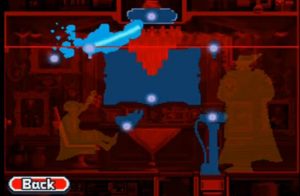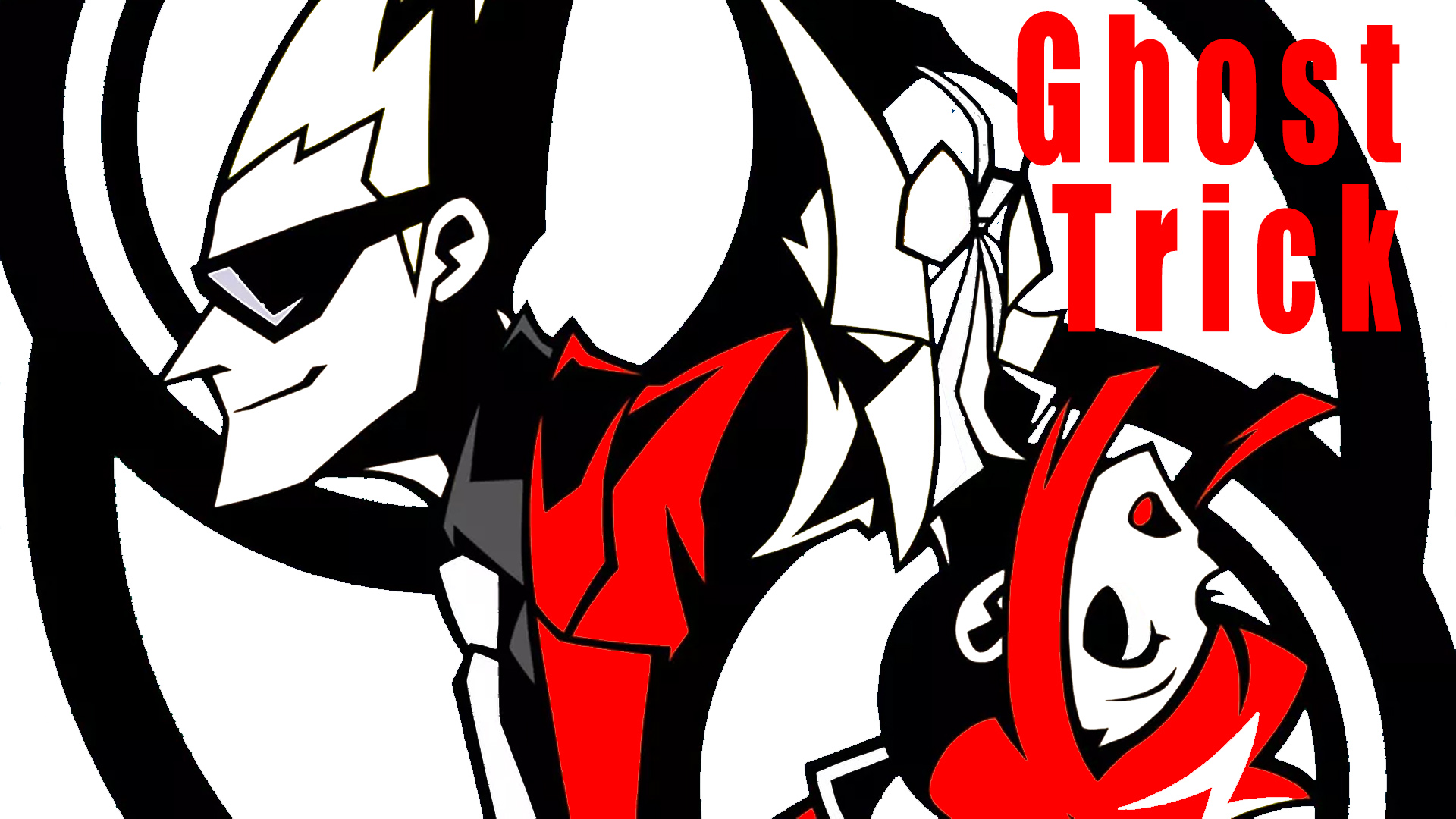Have I ever mentioned I love a good mystery? Maybe it started with my childhood affection for Encyclopedia Brown books, or perhaps even earlier with my adoration of Disney’s The Great Mouse Detective. Whatever the case may be, my fondness for sleuthing didn’t really take hold until I got into the Ace Attorney series. The sorts of bizarre and colorful lateral-thinking puzzles that lie at the core of the many murder mysteries throughout the series clicked with me instantly. So it’s no wonder that when I read in the now defunct Nintendo Power magazine that Shu Takumi, the creator of the Ace Attorney series, was making a new game about an amnesiac ghost trying to solve his own murder, I was immediately intrigued.
Ghost Trick was developed by Capcom and released for the DS in Japan on June 19, 2010 and internationally the following January with the subtitle “Phantom Detective”. I didn’t get my hands on the game until June, however. I remember when I got it quite clearly. My family and I were out on the town to celebrate my birthday when I stumbled across it during a detour in a Sam’s Club of all places. In accordance with family tradition, I asked my mom point blank if I could have it as my birthday present. As we were checking out, the clerk offhandedly mentioned he had never heard of the game. My mom, never missing an opportunity to brag about one of her children, assured him, “my son knows what’s up when it comes to video games. If he says a game’s cool, it’s really cool.”
I mean…she’s not wrong.
The Story
The plot of Ghost Trick begins with a young woman being held at gunpoint by an assassin. The main character, Sissel, would love to intervene, but there’s just one thing in his way: he’s already dead himself. Fortunately, another ghost who was passing through hears our hero’s lament and decides to teach him how to use the powers of the dead: “ghost tricks”. As it turns out, some ghosts have special powers, and Sissel’s power is the ability to manipulate inanimate objects.

Armed with this knowledge, Sissel sets out to foil the assassination…and fails. This is when the other ghost—who, having possessed a desk lamp, has elected to go by “Ray”—informs him of yet another ghost trick: the power to go back in time four minutes before the death of the recently deceased. Needless to say, Sissel doesn’t hesitate to ctrl-z the mysterious, red-headed woman back to life, and stops the assassination.
After reviving the girl, Sissel wonders who she is—only to realize that he doesn’t even remember who he is. Sissel then resolves to find out who he is and why he was killed. Ray, sympathetic to Sissel’s plight, offers some advice and a warning. He tells Sissel that he can use phone lines to travel quickly and advises he keep an eye on Lynne, the red-headed woman, as she is essential to uncovering the truth of what happened. Lastly, Ray informs Sissel that ghosts fade away after dawn, meaning he only has until sunrise to unravel the mystery of who he is.
And thus begins the story of Ghost Trick. I honestly don’t want to spoil anything else; this is a phenomenal story rife with twists, turns, and intrigue around every corner. The mystery is intricate and compelling, with the answer to each question often only raising more questions. This never feels like a cheap tease, either. Even if a discovery leads to more questions, the fact that there are more questions to answer feels like a discovery in itself, as the scope of mystery becomes increasingly apparent. It also helps that this story is superbly paced. I never had to go too long before encountering an engaging puzzle or uncovering a vital clue.
But the mystery is only part of the narrative’s charm. Much like the Ace Attorney games, Ghost Trick contains a copious cast of colorful and quirky characters. Every character is likable in some way, regardless of how big their role is in the story is. Case in point, Sissel still manages to come across as a genuinely compassionate person, even though he frequently refuses the requests of others. It’s not that he doesn’t want to help them, he just has his own priorities and not a lot of time; I’m sure we can all relate to that.
Every character is likable in some way, regardless of how big their role is in the story is.
Best of all, the character’s in Ghost Trick, despite their goofy personalities and odd eccentricities, feel like people. Many of them have flaws and regrets, make mistakes, and have believable lapses in judgment. I’d even argue the story’s main theme is facing up to one’s past mistakes and figuring out how to set things right.
Overall, the story strikes a nice balance of drama and levity, not unlike the Ace Attorney series or a well-written kid’s show, such as Avatar: The Last Airbender. The characters’ various personalities play off each other in a variety of humorous ways and no one hesitates to snark about each other’s quirks or point out some of the story’s stranger moments. That said, when it’s time to get serious, the game will hit you with every ounce of pathos it can muster. I’m not at all a mushy sort of person, but even my eyes started to glisten by the end of it.
Aesthetics
Let’s start with the visuals. The game’s official art sports a distinct, cartoony visual style, with bold outlines and shadows. I like the style, as the slightly exaggerated proportions and sometimes strange character designs accentuate the game’s humorous side, while the pronounced shadows hint at the game’s darker moments. What really sets this game apart visually, however, is its hypnotically smooth animation. Each character moves with a ridiculous amount of detail and fluidity. Moreover, the animation is absolutely dripping with personality. No joke, you can often times get a pretty good idea of who a character in this game is just by watching them walk. Each character is animated with his or her own little quirks and idiosyncrasies specific to them.

Ghost Trick doesn’t just look good, however, it sounds good too! The game’s soundtrack primarily utilizes a synth-funk style that’ll probably sound familiar to fans of the Ace Attorney series. Much like how the animation perfectly expresses each character’s personality, the music does a great job of conveying each scene’s tone and mood, be it goofy, tense, happy, mellow, or sad. This is especially true of the game’s main theme, which often plays after you save someone’s life. It really sells the triumphant sense of accomplishment while conveying a sense of momentum that makes you want to tackle the next obstacle.
Gameplay
Ghost Trick is, from a mechanical perspective, a pretty typical adventure game in structure. The game is split between narrative, puzzles, and some light exploration. But just because the gameplay follows a recognizable formula doesn’t mean it’s by any means ordinary!
As mentioned before, Sissel possesses the power to manipulate inanimate objects, travel across phone lines, and travel back in time to four minutes before someone’s death (if you’re wondering, “why four?”, it’s because of a pun that doesn’t translate). Using these “ghost tricks”, he has to navigate and manipulate his environments to further his quest to discover the truth. This leads to some incredibly inventive and challenging puzzles.

Puzzles typically require the player to manipulate the environment to engineer an elaborate Rube-Goldberg device to solve whatever problem is at hand. Sissel can’t possess every object, however, and not every object can be manipulated. These limitations lead to a surprising variety of puzzles. Sometimes the goal is to move an object into position, while many times the lynch-pin of the puzzle is figuring out how to get Sissel himself to the other side of the room! These puzzles aren’t easy, either: they’ll push your lateral thinking skills to their limits! The developers really didn’t pull any punches on the late-game challenges: there are plenty of times when objects need to be manipulated in a specific order, at a specific time, or even throwing in the occasional red-herring. This does, unfortunately, mean that many of the late-game puzzles rely on trial and error, but trust me when I say it’s totally worth it for that “aha” moment!
And that’s just how the game uses the manipulation mechanic! What, did you think that Ghost Trick simply relegated the phone-travel and time-rewinding elements to exploration and initiating puzzles? No, that’s one of the really cool things about Ghost Trick: all of its components are utilized in tandem! Many puzzles require the player to utilize all the abilities available to them. This not only improves variety, but also provides a sort of consistency between the game and its narrative as the abilities interact with each other in a natural and logical fashion.
Conclusion
What can I say? If it hasn’t become painfully obvious by now, this is one of my all-time favorite games. Ghost Trick seamlessly blends one of the most compelling and well-paced stories in any game I’ve ever played with creative and delightfully devious puzzles. Normally, this is where I’d lament that it never received a sequel but…something about the prospect of a sequel doesn’t feel right to me. This game’s ending ties up all of its loose ends, tapes them down, and welds them shut. Not only is there no more room to continue the narrative, but it’d also ruin just how perfect this game’s ending is. If this title were to ever receive a sequel, it’d either have to focus on a completely different cast of characters or happen in an alternate timeline or something. But honestly, I think this is a rare instance where the game stands on its own, as a wholly unique experience. Nothing like it, baby!
This game is available on DS and iOS. You can play a demo in your browser here (you’ll have to activate Flash). Seriously, if you love yourself, please play this game!


